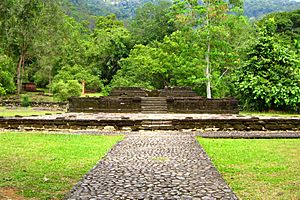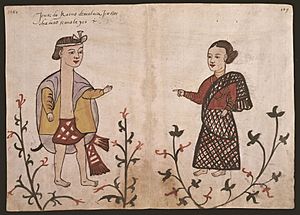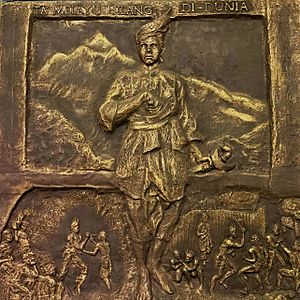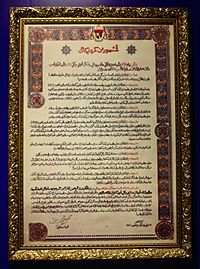Malaysian Malay facts for kids
| Melayu Malaysia ملايو مليسيا |
|
|---|---|
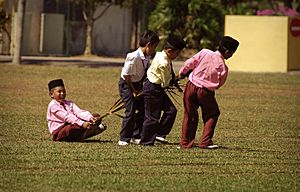
Malay children playing Tarik Upih Pinang, a traditional game that involves dragging a palm frond
|
|
| Total population | |
| 15,479,600 50.8% of the Malaysian population (2015) |
|
| Regions with significant populations | |
| Languages | |
| Predominantly Malaysian Malay (Varieties of Malay dialects) |
|
| Religion | |
| Predominantly |
|
| Related ethnic groups | |
|
Malaysian Malays are people in Malaysia who are part of the Malay ethnic group. Their family roots come from the Malay world, either fully or partly. In 2015, there were about 15.7 million Malaysian Malays, making up 50.8% of Malaysia's population. This makes them the largest ethnic group in the country.
Malaysian Malays can be divided into two main groups:
- Anak Jati: These are the original or local Malays. They follow the Malay culture found in the coastal areas of the Malay Peninsula and Borneo.
- Anak Dagang: These are often called "trading Malays" or "foreign Malays." They are descendants of people who moved from other parts of the Malay Archipelago. Over time, they became citizens of the Malay sultanates and adopted Malay culture. This happened easily because they shared similar lifestyles and the same religion.
Many Anak Dagang have ancestors from places like Indonesia, including Acehnese, Banjarese, Buginese, Javanese, Mandailing, and Minangkabau people. Some also come from other parts of the archipelago, like the Chams from Indochina, Cocos Malays from Australia's Cocos (Keeling) Islands, and Patani Malays from southern Thailand. A small number of Malays also have ancestors from other countries who have blended into the Malay Muslim culture more recently.
Contents
What Makes Someone Malay?
The idea of being Malay and being Muslim became strongly linked in the 15th century, during the time of the Melaka Sultanate. This period helped shape what it means to be Malay. Things like the Malay Rulers, the Malay language, Malay culture, and Islam became key parts of this identity. These ideas are now official in countries like Brunei and Malaysia.
In Malaysia, the definition of a Malay is written in Article 160 of the Constitution of Malaysia. This article says that a Malay is someone born to a Malaysian citizen who:
- Is a Muslim.
- Usually speaks the Malay language.
- Follows Malay customs.
- Lives in Malaysia, Singapore, or Brunei.
This definition is broad and can include people from different backgrounds who are "Malaysian Muslims." However, some Muslim groups in Malaysia, like Tamil Muslims or Chinese Muslims, have their own distinct cultures and languages. They are not considered Malay under this constitutional definition because they haven't fully adopted Malay culture.
This legal definition has made the Malay ethnoreligious identity very strong in Malaysia's laws. For example, it suggests that a Malay person cannot change their religion from Islam. As of the 2010 census, Malays made up 50.1% of Malaysia's population.
Malay Ancestry and Genetics
Studies on the genes of modern Malays show a mix of different human populations over time. This means Malays are genetically diverse, with differences between various Malay groups. These differences might come from living in separate areas and mixing with different groups over many years.
Scientists have found four main ancestral parts in Malay people:
- Austronesian: This is a large part of their genetic makeup. It's linked to people like the Ami and Atayal from Taiwan.
- Proto-Malay: This group, like the Temuan people, shows genetic signs of moving from Yunnan, China, about 4,000–6,000 years ago.
- East Asian: This mix might be more recent, perhaps 100–200 years ago.
- South Asian: This mix could be older, possibly up to 2,250 years ago for some Indonesian Malays.
There are also small contributions from other groups, such as the Negritos (the first people in the Malay Peninsula), Central Asians, and Europeans. Most of these mixing events happened between 175 and 1,500 years ago.
Within the Malay Peninsula, Malays in the north (like Melayu Kelantan and Melayu Kedah) are genetically similar to each other and to Thai Patani. However, they are different from Malays in the west and south (like Melayu Minang, Melayu Jawa, and Melayu Bugis). The southern groups are more closely related to people in Indonesia, showing they share common ancestors.
A Look Back at Malay History
The Malay World has been home to various Malayic Austronesian tribes since the last Ice age, around 15,000–10,000 BCE. Early Malayic tribes had a belief system called Animism, where they believed every natural object had a semangat (spirit).
Ancient settlements began to form along the coast of the Malay Peninsula. One important place is Sungai Batu, founded in 535 BC. It is considered the oldest evidence of civilization in Southeast Asia. These early settlements grew into city-states that traded with China and India. Between the 7th and 13th centuries, many of these small trading states became part of the powerful Srivijaya empire.
Islam arrived in the Malay Peninsula around the 12th century. The oldest proof of Islam here is the Terengganu Inscription Stone from the 14th century. By the 15th century, the Melaka Sultanate became a major center for Islam in the East. The word 'Melayu' (Malay) began to be used to describe the people of Melaka and their culture. When the Portuguese took over Melaka in 1511, the sultanate continued to be a model for new states like Johor, Perak, and Pahang.
Other sultanates also grew strong. In the north, Kedah, Kelantan, and Patani were important. The Bruneian Empire became powerful in Borneo in the mid-16th century. Later, in the 18th century, Minangkabau and Bugis settlers founded new states like Negeri Sembilan and Selangor.
Historically, Malay states often had conflicts with the Siamese. The British also began to gain control in the region. They acquired Penang in 1786, Singapore in 1819, and Dutch Malacca in 1824. These areas became known as the Straits Settlements. By 1895, the British had formed the Federated Malay States with Pahang, Selangor, Perak, and Negeri Sembilan. Later, in 1909, Kedah, Kelantan, Terengganu, and Perlis were also given to the British by Siam. These became the Unfederated Malay States. During World War II, the Japanese occupied all these British territories, which were known as British Malaya.
In the early 1900s, Malay nationalism began to grow. People started discussing what it meant to be a 'Malay nation' in terms of customs, religion, and language. After World War II, the British tried to create a single state called the Malayan Union. However, many Malays protested, leading to the formation of the Federation of Malaya. This federation later became Malaysia in 1963. The United Malays National Organization (UMNO) played a key role in promoting Malay language, Islam, and the Malay monarchy as central to Malay identity.
The Malay Language
Malay is the national language of Malaysia and is spoken by most people there. About 20% of all Malay speakers in the world live in Malaysia. The government calls it Bahasa Malaysia ("Malaysian language"), but the constitution still refers to it as Bahasa Melayu ("Malay language"). The official way to write Malay is using the Latin (Rumi) script, but the traditional Jawi script is also allowed. Jawi is still used in official religious documents, on signs, and taught in schools.
Malay is also spoken in Brunei, Indonesia, Singapore, East Timor, Thailand, and on Australia's Cocos and Christmas Islands. About 60 million people speak Standard Malay. There are also about 198 million people who speak Indonesian, which is a form of Malay. Standard Malay and Indonesian have some differences in words, pronunciation, and spelling, but speakers can usually understand each other.
The Malay language became widely used as a common language for trade during the Melaka Sultanate (1402–1511). During this time, the language grew quickly, influenced by Islamic writings. Many Arabic and Sanskrit words were added, creating what is known as Classical Malay.
Different versions of Malay exist across Malaysia, varying by state, district, or even village. The Melaka-Johor dialect became the standard for Malays in Brunei, Malaysia, and Singapore. It also formed the basis for the standardized Indonesian language. Some Malay dialects, like Kelantanese or Terengganuan, are quite different from Standard Malay and can be hard for standard speakers to understand.
Malay Culture
| Average Malay population of Malaya by state 1911-1947 | |||||||||||||||||||||||||||||||||||||||||||||||||||||||||||||||||||||||||||||||||||||||||||||||||||||||||||||||||||||||||||||||||||
|
Total: 1826307
|
||||||||||||||||||||||||||||||||||||||||||||||||||||||||||||||||||||||||||||||||||||||||||||||||||||||||||||||||||||||||||||||||||
| Source: Malayan Census | |||||||||||||||||||||||||||||||||||||||||||||||||||||||||||||||||||||||||||||||||||||||||||||||||||||||||||||||||||||||||||||||||||
In Malaysia, the state's constitution gives Malay rulers authority over Islam and Malay customs in their states. Councils called Majlis Agama Islam dan Adat Istiadat Melayu (Council of Islam and Malay Customs) advise the rulers and manage Islamic affairs and Malay traditions (adat). Legal cases related to these matters are handled in Syariah Courts.
Malay culture has roots in early settlers, including both Malayic-speaking Austronesians and Austroasiatic tribes. Around the start of the common era, Dharmic religions (like Hinduism and Buddhism) were introduced. They thrived with the creation of many ancient trading states along the coasts. Many cultural traditions from these old states still exist among Malays on the east coast, in the north, and in Borneo.
The traditional culture of Malaysian Malays is mostly based on indigenous Malay culture mixed with influences from other countries. Malays in the southern states (Selangor, Negeri Sembilan, Melaka, and Johor) show the cultural legacy of the Melaka Sultanate. Key parts of Malay identity – Islam, the Malay language, and Malay customs – are thought to have become strong in this region. This area also shows influences from other parts of the Malay archipelago due to large migrations in the 17th century. For example, Minangkabau people settled in Negeri Sembilan, and Buginese people formed the Selangor sultanate and settled in Johor.
Over time, many non-Malay indigenous people, like the Dayak, Orang Asli, and Orang Laut, adopted Malay culture. They converted to Islam, learned to speak Malay, and dressed like Malays. Malays have always been known as a coastal-trading community with a flexible culture. They have taken in, shared, and passed on many cultural features from other ethnic groups. This mixing of local Malay culture with foreign cultures also led to the development of related cultures, such as Arab Peranakan, Baba Nyonya, Chetti Melaka, Jawi Pekan, Kristang, Sam-sam, and Punjabi Peranakan.
Today, some Malays have recent ancestors from other parts of maritime Southeast Asia. These are the anak dagang ("traders") or foreign Malays who have blended into Malay culture. Other groups include Acehnese in Kedah, Banjarese and Mandailing in Perak, Chams and Patani Malays in Kelantan and Terengganu, and Cocos Malays in Sabah. Between the 19th and early 20th centuries, many immigrants from Java and Sumatra came to Malaya as traders, settlers, and workers. British records show that many of these immigrants, especially Javanese, settled on the west coast of the Malay Peninsula. These groups adapted and blended in, creating new Malay communities that still have ties to their cultural roots in Java and Sumatra.
In 1971, the government created a "National Culture Policy" for Malaysian culture. Its three main ideas are:
- Malaysian culture must be based on the local culture of the region, which is Malay culture.
- It can include suitable elements from other cultures.
- Islam must play a part in it.
Much of Malaysian culture shows strong influences from Malay culture. For example, the practice of Keramat shrine worshipping, common among Malaysian Chinese, comes from Malay culture. Other Malay cultural influences can be seen in traditional dress, food, literature, music, arts, and architecture. Traditional Malay dress varies by region, but the most popular modern dresses are Baju Kurung and Baju Kebaya (for women) and Baju Melayu (for men). These are recognized as Malaysia's national dress.
Many other Malay cultural items are considered Malaysian national heritage. These include traditional performing arts like Mak Yong, Dondang Sayang, and Wayang Kulit, martial arts like Silat, and traditional crafts like Songket and Batik. The rich classical Malay literature tradition and various types of Malay folklore also form the basis of modern Malaysian literature and folklore. Malay traditional music has also greatly influenced the Malaysian music scene, leading to genres like Irama Malaysia which combines Malay social dances and music styles such as Asli, Inang, and Joget.
Malaysian Malays Around the World
There is a community of Malaysian Malays who make up 20% of the total population on Christmas Island, an Australian external territory.
Malay Population in Malaysia
Malays are the largest ethnic group in Malaysia. In most states, Malays make up about 40% to over 90% of the population. However, in Sabah and Sarawak, Malays are less than 30% of the population. The numbers below are from the 2010 census and 2015 estimates, including both citizens and non-citizens.
| State | Population | |||||||
|---|---|---|---|---|---|---|---|---|
| 2010 | 2015|- | Johor | 1,759,537 | 52.6% | 1,893,100 | 53.2% | ||
| Kedah | 1,460,746 | 75.0% | 1,569,100 | 75.7% | ||||
| Kelantan | 1,426,373 | 92.6% | 1,585,900 | 92.3% | ||||
| Malacca | 517,441 | 63.0% | 552,700 | 63.3% | ||||
| Negeri Sembilan | 572,006 | 56.0% | 621,900 | 56.6% | ||||
| Pahang | 1,052,774 | 70.1% | 1,146,000 | 70.6% | ||||
| Perak | 1,238,357 | 52.6% | 1,314,400 | 53.0% | ||||
| Penang | 636,146 | 40.7% | 692,400 | 41.6% | ||||
| Perlis | 198,710 | 85.8% | 210,200 | 85.4% | ||||
| Sabah | 184,197 | 5.7% | 268,500 | 7.6% | ||||
| Sarawak | 568,113 | 23.0% | 616,900 | 23.4% | ||||
| Selangor | 2,814,597 | 51.5% | 3,069,100 | 52.2% | ||||
| Terengganu | 985,011 | 95.1% | 1,092,200 | 94.7% | ||||
| Kuala Lumpur | 679,236 | 40.8% | 729,500 | 41.3% | ||||
| Labuan | 30,001 | 34.5% | 33,900 | 35.0% | ||||
| Putrajaya | 68,475 | 94.6% | 83,800 | 94.9% | ||||
| Malaysia total | 14,191,720 | 50.1% | 15,479,600 | 50.8% | ||||
|
||||||||
Images for kids
See also
 In Spanish: Idioma malasio para niños
In Spanish: Idioma malasio para niños


